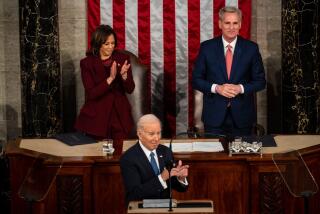PERSPECTIVE ON JAPAN : Still Time to Beat Back Doomsayers : But at minimum, a tax cut is needed, then a plan to reverse long-term imbalances or risk fulfilling the prophecy.
- Share via
TOKYO — Japan’s economy is caught in the wrenching grip of a policy-induced recession. As elsewhere, the promised soft landing has turned into a very bumpy ride. The drumbeat of pessimism continues to pound confidence lower. While still above the levels of the energy-induced recession of two decades ago, all surveys concur that the outlook is as negative as it has been at anytime since. Over the past 12 months, the economy has performed at but half the official forecast for the year.
Yet despite the pessimism, Japanese authorities are still in a most enviable position. The country is the only major economy to run a comfortable budgetary surplus. While the seven major industrial countries (G-7) as a whole ran a current account deficit of $140 billion last year, Japan’s surplus was $118 billion. While unemployment ravages the economies of Europe and continues to grate away at confidence in Canada and the United States, the jobless rate has climbed only by a few tenths of a point in Japan since the beginning of the slowdown. Even at the lowest point in the recession, the economy continued to expand. Since the onset of recession, households have actually increased their savings, which are now running at just over 19% of income.
This situation leaves Japanese authorities with a margin for maneuvering that other G-7 leaders can only dream about. With the United States now beginning to address in a positive manner its own deep and troubling economic situation, and Germany carrying the principal burden of financial support for Eastern Europe and the former Soviet Union, Japan’s own largely positive situation places new and heavy responsibilities on Tokyo to assume a much larger role in pulling the world economy out of deflation.
Although Japan has substantially cut interest rates and provided additional stimulus for the economy last year, additional stimulus is clearly required to move the economy back toward its long-term potential of 4% growth. To do so would require an additional 10 trillion yen of stimulus over the next 18 months.
There is no point in Japan stonewalling until the G-7 summit in Tokyo in July before it moves to put the economy back on track. Indeed, the longer Tokyo refuses to move, the more difficult it will be for the United States to sustain its current rebound, particularly in the context of budget cuts and tax increases that are now in the pipeline.
Similarly, each day that the Japanese economy continues to under-perform its potential, the weaker are the country’s imports and the stronger are its exports. Already, Japan’s trade account is on track for a new, record-shattering surplus of $160 billion this year. That is nearly four times what the surplus was on the eve of the accord in New York in the mid-1980s, and clearly has become a major cause for climbing trade tensions around the world. It was interesting in this regard that President Clinton, in his address in Seattle last week, intimated that in the mid-1980s, there was a generalized problem of trade, but that today, Europe, Asia and America all have escalating trade problems with Japan. From there, it is but one short step for the problem of trade to become the Japan problem.
Finally, more growth in Japan would provide the type of buoyancy in the world economy that is so required by Europe in support of its efforts to consolidate the difficult transition in the east. More deflation can only raise the odds that the great opportunities brought by the collapse of the Berlin Wall will slip from grasp.
From here, the most effective form of stimulus Japan could take would be a clear reduction in personal income taxes. That would put new spending power directly in the hands of the consumer and also constitute a significant boost to confidence, which would trigger further domestic demand and consumer spending.
Tokyo authorities should also be encouraged to take a less passive approach to rebuilding Japanese bank balance sheets. The mess in the banking system is largely a result of the policy adopted in the mid-1980s that permitted the unbridled real-estate speculation. Cleaning up that mess is not only critical to the reversal in the deflationary decline of bank lending, but also to the smooth recycling of the country’s unprecedented current account surpluses to the world economy.
Should this whole process be in any way disrupted, the implications for America’s economy and financial markets, in particular, would be immediate and dire. Should the Japan’s financial system fail to carry out the recycling of the nation’s surpluses to the world economy, the size of the funds involved would critically destabilize world markets. Critical to the success of America’s new economic policies is continuing low-interest rates. Any disruption from Tokyo would lead global interest rates quickly in the wrong direction.
The scope of the policy measures set out above is only short-term. To reverse the dynamics of Japan’s still-building, long-term imbalances, an intermediate-term, structural program must also be set in place. To do less, or to do otherwise, could only increase the risk of an eventual rupture in world financial markets as tensions and imbalances between Japan and its principal G-7 partners become unmanageable.
More to Read
Sign up for Essential California
The most important California stories and recommendations in your inbox every morning.
You may occasionally receive promotional content from the Los Angeles Times.













